The global automotive hybrid IGBTs market is valued at USD 1,137.7 million and is projected to expand to USD 3,565.2 million, representing an absolute increase of USD 2,427.5 million by the end of 2035. This indicates a compound annual growth rate of 12.1% and results in an industry that is 3.13 times larger than the baseline period, starting in 2025.
The annual expansion begins with a base of USD 1,137.7 million, and each year adds between USD 130 million and USD 200 million in the early stages. The YoY growth rate remains consistent at around 12.1%, but absolute increments grow steadily as the automotive hybrid IGBTs market expands. By 2026, the industry value is expected to cross USD 1,275 million, showing an additional USD 137 million. By 2027, the size is expected to reach USD 1,430 million, representing an increase of nearly USD 155 million. The YoY contribution continues to strengthen, rising to about USD 174 million in 2028 and close to USD 195 million in 2029, highlighting how the compounding effect translates into progressively higher annual additions.
Entering the early 2030s, the industry surpasses the USD 2,000 million mark, and yearly increments rise above USD 220 million. For instance, the gain between 2030 and 2031 is projected at nearly USD 240 million, while between 2031 and 2032 the increase is expected at more than USD 270 million. These figures underscore how a stable percentage growth rate yields expanding absolute gains as the revenue base increases. By 2033, annual increments surpass USD 300 million, and by 2034, they edge closer to USD 340 million, culminating in an industry size of USD 3,565.2 million by 2035.
The YoY trend points at a clear compounding profile where the growth rate remains stable but absolute dollar additions rise sharply toward the end of the cycle. In the early stage, average annual additions are around USD 150–180 million, while in the final years they exceed USD 300 million. This means the last two years of the cycle add nearly as much value as the first three combined. The progression reflects both the deepening penetration of hybrid and electric vehicles and the increasing importance of IGBTs for energy-efficient powertrain solutions.
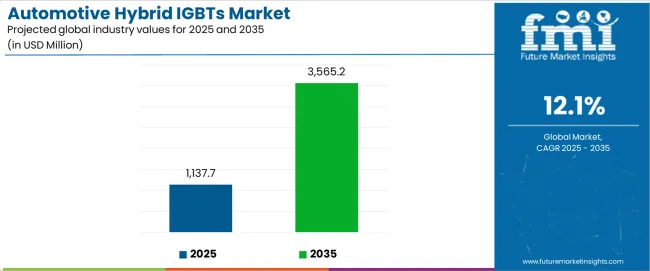
Between 2025 and 2030, the automotive hybrid IGBTs market is projected to expand from USD 1,137.7 million to USD 1,796.6 million, resulting in a value increase of USD 658.9 million, which represents 27.1% of the total forecast growth for the decade. This phase of development will be shaped by increasing adoption of hybrid electric vehicles, rising demand for high-performance power semiconductor devices, and growing emphasis on advanced inverter technologies with enhanced efficiency characteristics. Automotive manufacturers are expanding their electrification capabilities to address the growing demand for hybrid powertrains, energy conversion systems, and electric drive applications.
| Metric | Value |
|---|---|
| Estimated Value in (2025E) | USD 1,137.7 million |
| Forecast Value in (2035F) | USD 3,565.2 million |
| Forecast CAGR (2025 to 2035) | 12.1% |
From 2030 to 2035, the automotive hybrid IGBTs market is forecast to grow from USD 1,796.6 million to USD 3,565.2 million, adding another USD 1,768.6 million, which constitutes 72.9% of the overall ten-year expansion. This period is expected to be characterized by the expansion of next-generation IGBT technologies, the integration of silicon carbide hybrid solutions, and the development of ultra-high voltage platforms with enhanced switching capabilities. The growing adoption of full electric vehicle architectures will drive demand for automotive hybrid IGBTs with superior thermal management and compatibility with advanced motor control systems across automotive applications.
Between 2020 and 2025, the automotive hybrid IGBTs market experienced robust growth, driven by increasing demand for electric vehicle adoption and growing recognition of power semiconductor technology as essential components for efficient energy conversion across hybrid powertrains, motor drives, and charging infrastructure applications. The automotive hybrid IGBTs market developed as automakers recognized the potential for IGBTs to improve powertrain efficiency while maintaining performance characteristics and enabling cost-effective electrification protocols. Technological advancements in switching frequency optimization and thermal management systems have begun to emphasize the critical importance of maintaining power density and reliability standards in diverse automotive environments.
Market expansion is being supported by the increasing global demand for electric and hybrid vehicle solutions and the corresponding need for advanced power semiconductor systems that can provide superior switching performance and thermal efficiency while enabling reduced energy losses and enhanced powertrain performance across various automotive and transportation applications. Modern automotive manufacturers and power electronics specialists are increasingly focused on implementing IGBT technologies that can deliver optimized power conversion, prevent system failures, and provide consistent performance throughout complex driving conditions and diverse vehicle architectures. Automotive hybrid igbts' proven ability to deliver exceptional efficiency against power conversion requirements, enable high-frequency switching operations, and support cost-effective electrification protocols make them essential components for contemporary automotive and electric vehicle operations.
The growing emphasis on automotive electrification and environmental regulations is driving demand for automotive hybrid IGBTs that can support high-power applications, improve energy conversion outcomes, and enable advanced motor control systems. Manufacturers' preference for technology that combines effective power management with operational reliability and thermal efficiency is creating opportunities for innovative IGBT implementations. The rising influence of electric mobility and advanced automotive electronics is also contributing to increased demand for automotive hybrid IGBTs that can provide high-voltage switching, real-time control capabilities, and reliable performance across extended operational periods.
The automotive hybrid IGBTs market is poised for rapid growth and transformation. As industries across automotive, transportation, renewable energy, and industrial automation seek solutions that deliver exceptional switching performance, thermal management, and energy efficiency, automotive hybrid IGBTs are gaining prominence not just as specialized semiconductors but as strategic enablers of modern electrification and power conversion.
Rising electric vehicle adoption in Asia-Pacific and expanding hybrid vehicle initiatives globally amplify demand, while manufacturers are leveraging innovations in silicon carbide integration, advanced packaging technologies, and intelligent gate driver systems.
Pathways like high-voltage IGBT modules, integrated power electronics, and specialized automotive-grade solutions promise strong margin uplift, especially in premium electric vehicle segments. Geographic expansion and technology integration will capture volume, particularly where local automotive manufacturing and electrification adoption are critical. Regulatory support around emissions reduction, energy efficiency standards, and automotive electrification mandates give structural support.
The automotive hybrid IGBTs market is segmented by voltage, application, technology type, vehicle type, end-use sector, and region. By voltage, the automotive hybrid IGBTs market is divided into 400V, 650V, 1200V, and other categories. By application, it covers EV (Electric Vehicles), HEV (Hybrid Electric Vehicles), charging infrastructure, and others. By technology type, the automotive hybrid IGBT market comprises planar IGBTs, trench IGBTs, and field-stop IGBTs. By vehicle type, it is categorized into passenger cars, commercial vehicles, and electric buses. By end-use sector, it covers automotive OEMs, tier-1 suppliers, aftermarket, and charging station operators. Regionally, the automotive hybrid IGBTs market is divided into North America, Europe, East Asia, South Asia & Pacific, Latin America, and the Middle East & Africa.
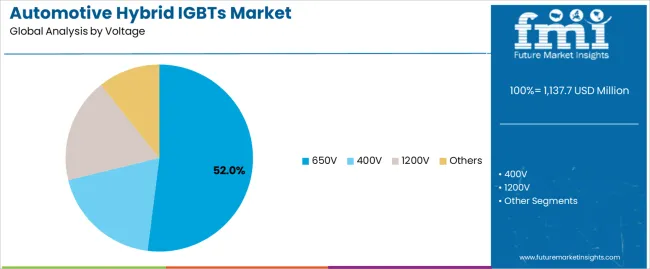
The 650V voltage segment is projected to account for 52.0% of the automotive hybrid IGBTs market in 2025, reaffirming its position as the leading voltage category. Automotive manufacturers and power electronics designers increasingly utilize 650V automotive hybrid IGBTs for their optimal balance between switching performance and thermal efficiency when operating across diverse hybrid vehicle architectures, excellent power density characteristics, and cost-effectiveness in applications ranging from motor drives to onboard charging systems. 650V automotive hybrid IGBT technology's advanced switching capabilities and proven reliability directly address the automotive requirements for comprehensive power conversion in modern electrified vehicles.
This voltage segment forms the foundation of modern hybrid vehicle powertrains, as it represents the IGBT type with the greatest market acceptance and established performance record across multiple application categories and vehicle platforms. Manufacturer investments in enhanced chip designs and advanced packaging technologies continue to strengthen adoption among automotive OEMs and tier-1 suppliers. With companies prioritizing power efficiency and thermal management optimization, 650V automotive hybrid IGBTs align with both performance requirements and cost optimization objectives, making them the central component of comprehensive automotive electrification strategies.
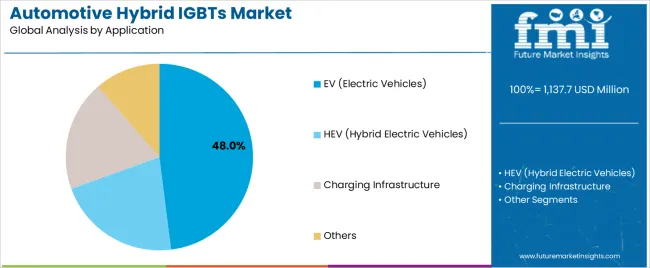
Electric vehicle applications are projected to represent 48% of automotive hybrid IGBTs demand in 2025, underscoring their critical role as the primary automotive consumers of advanced power semiconductor technology for motor control, energy conversion, and power management applications. EV manufacturers prefer automotive hybrid IGBTs for their exceptional switching efficiency capabilities, high-power handling characteristics, and ability to optimize energy conversion while ensuring reliable operation throughout diverse driving conditions and performance requirements. Positioned as essential components for modern electric vehicle systems, automotive hybrid IGBTs offer both efficiency advantages and reliability benefits.
The segment is supported by continuous innovation in power module technologies and the growing availability of specialized automotive-grade solutions that enable high-frequency switching with enhanced thermal performance and rapid power conversion capabilities. Additionally, EV manufacturers are investing in advanced power electronics systems to support high-performance motor drives and energy management. As electric vehicle demand becomes more prevalent and automotive electrification requirements increase, EV applications will continue to dominate the end-use market while supporting advanced powertrain automation utilization and energy conversion strategies.
The automotive hybrid IGBTs market is advancing rapidly due to increasing demand for electric vehicle technologies and growing adoption of advanced power semiconductor solutions that provide superior switching performance and thermal efficiency while enabling reduced energy losses across diverse automotive and electrification applications. However, the automotive hybrid IGBTs market faces challenges, including high development costs, complex automotive qualification requirements, and the need for specialized thermal management and reliability validation programs. Innovation in silicon carbide integration and advanced packaging systems continues to influence product development and market expansion patterns.
The growing adoption of silicon carbide integration, wide bandgap semiconductor combinations, and hybrid power module architectures is enabling manufacturers to produce advanced automotive hybrid IGBTs with superior switching characteristics, enhanced thermal performance, and optimized power density functionalities. Advanced hybrid technologies provide improved efficiency while allowing higher operating temperatures and consistent performance across various vehicle platforms and power levels. Manufacturers are increasingly recognizing the competitive advantages of siC hybrid capabilities for performance differentiation and premium market positioning.
Modern automotive hybrid IGBT producers are incorporating smart gate drivers, integrated current sensing, and digital control interfaces to enhance operational intelligence, enable predictive maintenance capabilities, and deliver value-added solutions to automotive customers. These technologies improve powertrain efficiency while enabling new operational capabilities, including real-time fault detection, adaptive switching optimization, and reduced system complexity. Advanced integration also allows manufacturers to support comprehensive vehicle electrification systems and automotive modernization beyond traditional discrete semiconductor approaches.
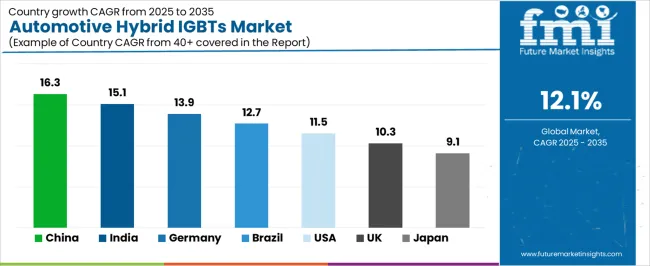
| Country | CAGR (2025 to 2035) |
|---|---|
| China | 16.3% |
| India | 15.1% |
| Germany | 13.9% |
| Brazil | 12.7% |
| USA | 11.5% |
| UK | 10.3% |
| Japan | 9.1% |
The automotive hybrid IGBTs market is experiencing strong growth globally, with China leading at a 16.3% CAGR through 2035, driven by the expanding electric vehicle manufacturing programs, growing automotive electrification adoption, and significant investment in power semiconductor development. India follows at 15.1%, supported by government initiatives promoting electric mobility, increasing automotive manufacturing demand, and growing power electronics requirements. Germany shows growth at 13.9%, emphasizing automotive technology innovation and advanced power semiconductor development. Brazil records 12.7%, focusing on automotive manufacturing expansion and electrification modernization. The USA demonstrates 11.5% growth, prioritizing automotive efficiency standards and electric vehicle excellence. The UK exhibits 10.3% growth, emphasizing automotive technology adoption and electrification development. Japan shows 9.1% growth, supported by advanced automotive electronics initiatives and power semiconductor concentration.
The report covers an in-depth analysis of 40+ countries top-performing countries are highlighted below.
Revenue from automotive hybrid IGBTs in China is projected to exhibit exceptional growth with a CAGR of 16.3% through 2035, driven by expanding electric vehicle manufacturing programs and rapidly growing automotive electrification adoption supported by government initiatives promoting power semiconductor development. The country's strong position in EV production and increasing investment in automotive electronics infrastructure are creating substantial demand for advanced automotive hybrid IGBT solutions. Major automotive manufacturers and power electronics companies are establishing comprehensive IGBT production capabilities to serve both domestic electric vehicle demand and automotive export markets.
Revenue from automotive hybrid IGBTs in India is expanding at a CAGR of 15.1%, supported by the country's growing automotive sector, expanding government support for electric mobility, and increasing adoption of advanced automotive electronics solutions. The country's initiatives promoting electric vehicle technology and growing manufacturer awareness are driving requirements for advanced power semiconductor capabilities. International suppliers and domestic manufacturers are establishing extensive production and service capabilities to address the growing demand for automotive hybrid IGBT products.
Revenue from automotive hybrid IGBTs in Germany is expanding at a CAGR of 13.9%, supported by the country's advanced automotive engineering capabilities, strong emphasis on automotive technology innovation, and robust demand for high-performance power electronics in vehicle electrification and automotive systems applications. The nation's mature automotive sector and efficiency-focused operations are driving sophisticated automotive hybrid IGBT systems throughout the automotive industry. Leading manufacturers and technology providers are investing extensively in advanced power modules and next-generation semiconductor technologies to serve both domestic and international markets.
Revenue from automotive hybrid IGBTs in Brazil is growing at a CAGR of 12.7%, driven by the country's expanding automotive manufacturing sector, growing vehicle production operations, and increasing investment in automotive technology development. Brazil's automotive industry growth and commitment to manufacturing modernization are supporting demand for efficient automotive hybrid IGBT solutions across multiple vehicle production segments. Manufacturers are establishing comprehensive service capabilities to serve the growing domestic market and automotive export opportunities.
Revenue from automotive hybrid IGBTs in the USA is expanding at a CAGR of 11.5%, supported by the country's advanced automotive technology sector, strategic focus on vehicle efficiency, and established electric vehicle capabilities. The USA's automotive innovation leadership and technology integration are driving demand for automotive hybrid IGBTs in vehicle manufacturing, advanced powertrain systems, and automotive electronics applications. Manufacturers are investing in comprehensive technology development to serve both domestic automotive markets and international specialty applications.
Revenue from automotive hybrid IGBTs in the UK is growing at a CAGR of 10.3%, driven by the country's focus on automotive technology advancement, emphasis on vehicle efficiency, and strong position in electric vehicle development. The UK's established automotive innovation capabilities and commitment to electrification modernization are supporting investment in advanced power semiconductor technologies throughout major automotive regions. Industry leaders are establishing comprehensive technology integration systems to serve domestic vehicle manufacturing operations and specialty automotive applications.
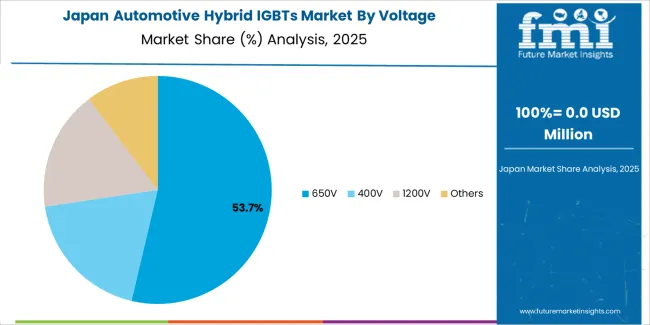
Revenue from automotive hybrid IGBTs in Japan is expanding at a CAGR of 9.1%, supported by the country's advanced automotive electronics initiatives, growing power semiconductor sector, and strategic emphasis on automotive technology development. Japan's advanced technology capabilities and integrated automotive systems are driving demand for sophisticated automotive hybrid IGBTs in hybrid vehicle production, advanced automotive electronics, and high-performance automotive applications. Leading manufacturers are investing in specialized capabilities to serve the stringent requirements of advanced automotive and power electronics industries.
The automotive hybrid IGBTs market in Europe is projected to grow from USD 158.2 million in 2025 to USD 495.8 million by 2035, registering a CAGR of 12.1% over the forecast period. Germany is expected to maintain its leadership position with a 38.5% market share in 2025, declining slightly to 37.8% by 2035, supported by its strong automotive manufacturing sector, advanced power electronics capabilities, and comprehensive automotive electrification industry serving diverse automotive hybrid IGBT applications across Europe.
France follows with a 19.2% share in 2025, projected to reach 19.8% by 2035, driven by robust demand for automotive hybrid IGBTs in automotive manufacturing, electrification programs, and advanced vehicle systems, combined with established automotive technology infrastructure and power electronics expertise. The United Kingdom holds a 16.5% share in 2025, expected to reach 17.1% by 2035, supported by strong automotive technology sector and growing electric vehicle activities. Italy commands a 11.8% share in 2025, projected to reach 12.2% by 2035, while Spain accounts for 8.7% in 2025, expected to reach 9.0% by 2035. The Netherlands maintains a 3.2% share in 2025, growing to 3.4% by 2035. The Rest of Europe region, including Nordic countries, Eastern Europe, Belgium, Poland, and other nations, is anticipated to maintain momentum, with its collective share moving from 2.1% to 0.7% by 2035, attributed to increasing automotive electrification in Eastern Europe and growing power electronics penetration in Nordic countries implementing advanced automotive technology programs.
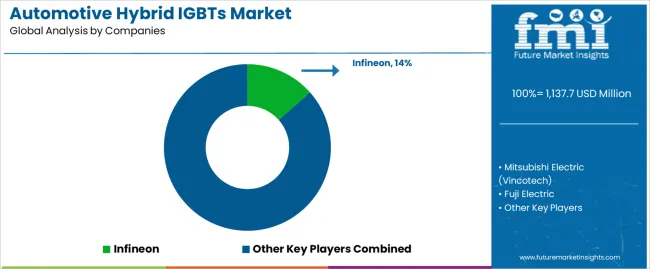
The automotive hybrid IGBTs market is characterized by competition among established power semiconductor manufacturers, specialized automotive electronics producers, and integrated power module solutions providers. Companies are investing in silicon carbide integration research, thermal management optimization, advanced packaging development, and comprehensive product portfolios to deliver consistent, high-performance, and automotive-qualified automotive hybrid IGBT solutions. Innovation in intelligent gate drivers, power module integration, and operational efficiency enhancement is central to strengthening market position and competitive advantage.
Infineon leads the automotive hybrid IGBTs market with a strong market share, offering comprehensive automotive hybrid IGBT solutions including advanced power modules with a focus on automotive and industrial applications. Mitsubishi Electric (Vincotech) provides specialized power semiconductor capabilities with an emphasis on automotive-grade modules and integrated power solutions. Fuji Electric delivers innovative power electronics products with a focus on high-voltage platforms and automotive qualification. Hitachi Power Semiconductor Device specializes in advanced IGBT technologies and automotive power modules for electrified vehicle applications. Bosch focuses on automotive electronics integration and comprehensive powertrain solutions. Onsemi offers specialized semiconductor platforms with emphasis on automotive and power management applications.
| Items | Values |
|---|---|
| Quantitative Units (2025) | USD 1,137.7 million |
| Voltage | 400V, 650V, 1200V, Others |
| Application | ev, Hev, Charging Infrastructure, Others |
| Technology Type | Planar igbt, Trench igbt, Field-Stop igbt |
| Vehicle Type | Passenger Cars, Commercial Vehicles, Electric Buses |
| End-Use Sector | Automotive OEMs, Tier-1 Suppliers, Aftermarket, Charging Station Operators |
| Regions Covered | North America, Europe, East Asia, South Asia & Pacific, Latin America, Middle East & Africa |
| Countries Covered | China, India, Germany, Brazil, United States, United Kingdom, Japan and 40+ countries |
| Key Companies Profiled | Infineon, Mitsubishi Electric (Vincotech), Fuji Electric, Hitachi Power Semiconductor Device, Bosch, and Onsemi |
| Additional Attributes | Dollar sales by voltage and application category, regional demand trends, competitive landscape, technological advancements in silicon carbide integration, power module development, thermal management innovation, and automotive qualification integration |
The global automotive hybrid IGBTs market is estimated to be valued at USD 1,137.7 million in 2025.
The market size for the automotive hybrid IGBTs market is projected to reach USD 3,565.2 million by 2035.
The automotive hybrid IGBTs market is expected to grow at a 12.1% CAGR between 2025 and 2035.
The key product types in automotive hybrid IGBTs market are 650v, 400v, 1200v and others.
In terms of application, EV (electric vehicles) segment to command 48.0% share in the automotive hybrid IGBTs market in 2025.






Full Research Suite comprises of:
Market outlook & trends analysis
Interviews & case studies
Strategic recommendations
Vendor profiles & capabilities analysis
5-year forecasts
8 regions and 60+ country-level data splits
Market segment data splits
12 months of continuous data updates
DELIVERED AS:
PDF EXCEL ONLINE
Automotive Seating Market Size and Share Forecast Outlook 2025 to 2035
Automotive Appearance Chemical Market Size and Share Forecast Outlook 2025 to 2035
Automotive Remote Diagnostic Market Size and Share Forecast Outlook 2025 to 2035
Automotive-grade Inertial Navigation System Market Size and Share Forecast Outlook 2025 to 2035
Automotive Thin IGBT Module Market Size and Share Forecast Outlook 2025 to 2035
Automotive Hydrogen Leak Detection Sensors Market Size and Share Forecast Outlook 2025 to 2035
Automotive Exhaust Extraction Hose Reels Market Size and Share Forecast Outlook 2025 to 2035
Automotive Electroplating Service Market Size and Share Forecast Outlook 2025 to 2035
Automotive Manufacturing Equipment Market Size and Share Forecast Outlook 2025 to 2035
Automotive Pressure Sensor Market Size and Share Forecast Outlook 2025 to 2035
Automotive Vacuum Brake Booster Market Size and Share Forecast Outlook 2025 to 2035
Automotive Smart Antenna Market Size and Share Forecast Outlook 2025 to 2035
Automotive Actuator Market Size and Share Forecast Outlook 2025 to 2035
Automotive Exhaust Manifold Market Size and Share Forecast Outlook 2025 to 2035
Automotive Roof Rails Market Size and Share Forecast Outlook 2025 to 2035
Automotive Resonator Market Size and Share Forecast Outlook 2025 to 2035
Automotive Counter Shaft Market Size and Share Forecast Outlook 2025 to 2035
Automotive Wheel Coating Market Size and Share Forecast Outlook 2025 to 2035
Automotive Water Separation Systems Market Size and Share Forecast Outlook 2025 to 2035
Automotive Refinish Coating Market Size and Share Forecast Outlook 2025 to 2035

Thank you!
You will receive an email from our Business Development Manager. Please be sure to check your SPAM/JUNK folder too.
Chat With
MaRIA